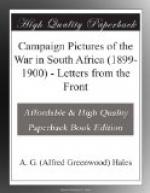I do not think it wrong so to utilise a church. It is the only place fit to put the wounded men in in all the town. The great Nazarene in whose name the church was erected would not have allowed the sick to wither by the wayside in the days when the Judean hills rang to the echo of His magnetic voice, nor do I think it wrongful to His memory to convert His shrine into an abiding place for the sick and suffering.
Far away on our left flank the enemy hold the heights, and watch us moving outward, whilst between them and us, stretching mile after mile in a line with our column, ripples a line of scarlet flame, for the foe has fired the veldt to starve the transit mules, horses, and oxen. Like a sword unsheathed in the sunlight, the flames sparkle amidst the grass, which grows knee-deep right to the kopje’s very lips. Birds rise on the wing with harsh, resonant cries, flutter awhile above their ravished homes, then wheel in mid-air and seek more peaceful pastures. Hares spring up before the crackling flames quite reach their forms, and, like grey streaks in a sailor’s beard on a stormy day, flash suddenly into view, and as suddenly disappear again. Here and there a graceful springbok dashes through the smoke, with head thrown back and graceful limbs extended, his glossy, mottled hide looking doubly beautiful backed by that red streak of fire. The wind catches the quivering crimson streak, and for awhile the flames race, as I have seen wild horses, neck to neck, rush through the saltbush plains at the sound of the stockman’s whip. Then, as the wind drops, the flames curl caressingly around the wealth of growing fodder, biting the grass low down, and wrapping it in a mantle of black and red, as flame and smoke commingle.
Here and there a pool of water, hidden from view until the fire fiend stripped the veldt land bare, leaps to life like a silver shield in the grim setting of the bare and blackened plain. Small mobs of cattle stand stupidly snuffing the smoke-laden air, until the breath of the blaze awakens them to a sense of peril; then, with horns lowered like bayonets at the charge, with tails stiff and straight behind them as levelled lances, they leap onward, over or through everything in front of them, bellowing frantically their brute beast protest against the red ruin of war. The flames roll on; they reach the stone walls of a cattle pen, and leap it as a hunter takes a brush fence in his stride; onward still, until a Kaffir kraal is reached. The soft-lipped billows kiss the uncouth mud wall, and for a moment transfigure them with a nameless beauty, the beauty that precedes ruin. Only a moment or two, and then the resistless destroyer flaunts its pennons amidst the reed-thatched roofs; the sparks leap up, the black smoke curls towards the sky, whilst on the neighbouring hills the negro women, with their babes in their arms, wail woefully, for those rude huts, with all their barbarous trappings, meant home—aye, home and happiness—to




